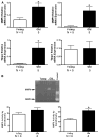Predisposition for disrepair in the aged lung
- PMID: 22173045
- PMCID: PMC3395069
- DOI: 10.1097/MAJ.0b013e318234c132
Predisposition for disrepair in the aged lung
Abstract
Introduction: Idiopathic pulmonary fibrosis (IPF) is a devastating progressive lung disease with an average survival of only 3 to 5 years. The mechanisms underlying the initiation and progression of IPF are poorly understood, and treatments available have only modest effect on disease progression. Interestingly, the incidence of IPF is approximately 60 times more common in individuals aged 75 years and older, but the mechanism by which aging promotes fibrosis is unclear. The authors hypothesized that aged lungs have a profibrotic phenotype that render it susceptible to disrepair after injury.
Methods: Young and old mice were treated with bleomycin to examine disrepair in the aged lung. In addition, uninjured young and old mouse lungs were analyzed for transforming growth factor-beta 1 (TGF-β1) production, extracellular matrix composition and lung fibroblast phenotype. Lung fibroblasts were treated with a DNA methyltransferase inhibitor to examine the potential epigenetic mechanisms involved in age-associated phenotypic alterations.
Results: The lungs of old mice showed worse fibrosis after bleomycin-induced injury compared with the lungs from young mice. At baseline, aged lungs expressed a profibrotic phenotype characterized by increased mRNA expression for fibronectin extracellular domain A (Fn-EDA) and the matrix metalloproteinases (MMPs) MMP-2 and MMP-9. Old lungs also expressed higher levels of TGF-β receptor 1 and TGF-β1 mRNA, protein and activity as determined by increased Smad3 expression, protein phosphorylation and DNA binding. Lung fibroblasts harvested from aged lungs showed reduced expression of the surface molecule Thy-1, a finding also implicated in lung fibrosis; the latter did not seem related to Thy-1 gene methylation.
Conclusion: Altogether, aged lungs manifest a profibrotic phenotype characterized by enhanced fibronectin extracellular domain A and MMP expression and increased TGF-β1 expression and signaling and are populated by Thy-1-negative fibroblasts, all implicated in the pathogenesis of lung fibrosis.
Figures








References
-
- Mora AL, Rojas M. Aging and lung injury repair: a role for bone marrow derived mesenchymal stem cells. J Cell Biochem. 2008;105:641–7. - PubMed
-
- Lawson WE, Crossno PF, Polosukhin VV, et al. Endoplasmic reticulum stress in alveolar epithelial cells is prominent in IPF: association with altered surfactant protein processing and herpesvirus infection. Am J Physiol Lung Cell Mol Physiol. 2008;294:L1119–26. - PubMed
-
- Ito K, Barnes PJ. COPD as a disease of accelerated lung aging. Chest. 2009;135:173–80. - PubMed
Publication types
MeSH terms
Substances
Grants and funding
LinkOut - more resources
Full Text Sources
Other Literature Sources
Miscellaneous

